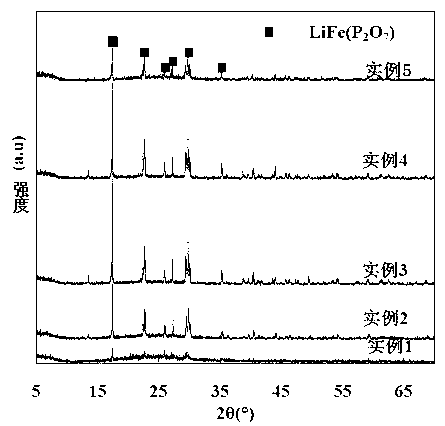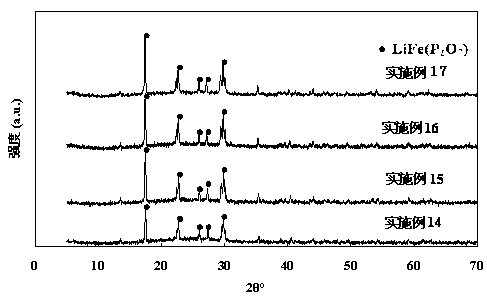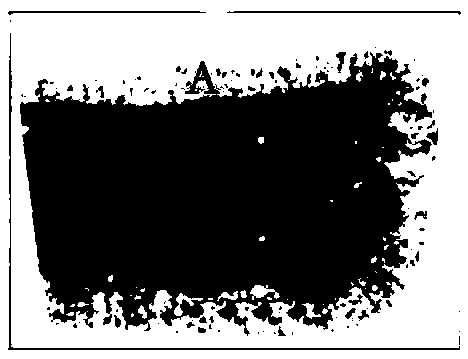Method for promoting surface crystallization of glass
A glass surface and glass technology, which is applied in the field of promoting glass surface crystallization, can solve the problems of unsuitable and invisible bulk glass, and achieve the effects of shortening heat treatment time, remarkable effect and simple and easy process.
- Summary
- Abstract
- Description
- Claims
- Application Information
AI Technical Summary
Problems solved by technology
Method used
Image
Examples
Embodiment 1
[0029] The glass composition is Li 2 O 8%, Fe 2 o 3 29%, P 2 o 5 63%, the preparation method is as follows:
[0030] Weigh the raw materials according to the above mass percentages and mix them evenly, put the mixture into a quartz crucible and melt it in a silicon carbide rod electric furnace at 1200 °C for 1 hour; pour the glass liquid into a preheated mold, and quickly Move it to a muffle furnace that has been heated to 300-400 ° C, keep it warm for 1 hour and anneal. Turn off the muffle furnace and cool down to room temperature. After annealing, the small glass sample was heated at a rate of 5 °C / min to the crystal nucleus formation temperature of 440 °C and kept for 2 hours; then at the same rate of heating to the crystallization peak temperature of 565 °C and kept for 2 hours. After heat treatment, the thickness of the crystallization layer was analyzed by optical microscope, and the thickness of the crystallization layer was 361.6 μm, and the main crystal phase ...
Embodiment 2
[0032] The glass composition is Li 2 O 8%, Fe 2 o 3 29%, P 2 o 5 63%, plus the crystallization promoting agent Cr 2 o 3 5%. The preparation method is as follows:
[0033] Weigh the raw materials according to the above mass percentages and mix them evenly, put the mixture into a quartz crucible and melt it in a silicon carbide rod electric furnace at 1200 °C for 1 hour; pour the glass liquid into a preheated mold, and quickly Move it to a muffle furnace that has been heated to 300-400 ° C, keep it warm for 1 hour and anneal. Turn off the muffle furnace and cool down to room temperature. After annealing, the small glass sample was heated at a rate of 5 °C / min to the crystal nucleus formation temperature of 490 °C and kept for 2 hours; then at the same rate of heating to the crystallization peak temperature of 620 °C and kept for 2 hours. The thickness of the crystallization layer of the sample after heat treatment was analyzed by optical microscope to be 1081.3 μm, an...
Embodiment 3
[0035] The glass composition is Li 2 O 8%, Fe 2 o 3 29%, P 2 o 5 63%, plus crystallization promoting agent TiO 2 2%, Cr 2 o 3 3%. The preparation method is as follows:
[0036] Weigh the raw materials according to the above mass percentages and mix them evenly, put the mixture into a quartz crucible and melt it in a silicon carbide rod electric furnace at 1200 °C for 1 hour; pour the glass liquid into a preheated mold, and quickly Move it to a muffle furnace that has been heated to 300-400 ° C, keep it warm for 1 hour and anneal. Turn off the muffle furnace and cool down to room temperature. After annealing, the small glass sample was heated at a rate of 5 °C / min to the crystal nucleus formation temperature of 480 °C and kept for 2 hours; then at the same rate of heating to the crystallization peak temperature of 620 °C and kept for 2 hours. After heat treatment, the thickness of the crystallization layer was analyzed by optical microscope to be 2047.6 μm, and the ...
PUM
| Property | Measurement | Unit |
|---|---|---|
| Thickness | aaaaa | aaaaa |
| Thickness | aaaaa | aaaaa |
| Thickness | aaaaa | aaaaa |
Abstract
Description
Claims
Application Information
 Login to View More
Login to View More - R&D
- Intellectual Property
- Life Sciences
- Materials
- Tech Scout
- Unparalleled Data Quality
- Higher Quality Content
- 60% Fewer Hallucinations
Browse by: Latest US Patents, China's latest patents, Technical Efficacy Thesaurus, Application Domain, Technology Topic, Popular Technical Reports.
© 2025 PatSnap. All rights reserved.Legal|Privacy policy|Modern Slavery Act Transparency Statement|Sitemap|About US| Contact US: help@patsnap.com



